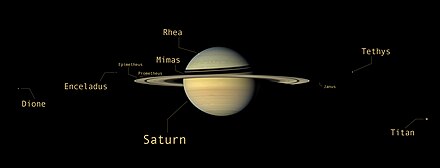
Back Saturnus se natuurlike satelliete Afrikaans أقمار زحل Arabic Satélites de Saturnu AST Saturnun peykləri Azerbaijani زوحل قمرلری AZB Спадарожнікі Сатурна Byelorussian Спадарожнікі Сатурна BE-X-OLD Естествени спътници на Сатурн Bulgarian Loarennoù Sadorn (planedenn) Breton Saturnovi prirodni sateliti BS

The moons of Saturn are numerous and diverse, ranging from tiny moonlets only tens of meters across to the enormous Titan, which is larger than the planet Mercury. There are 146 moons with confirmed orbits, the most of any planet in the solar system.[1][a] This number does not include the many thousands of moonlets embedded within Saturn's dense rings, nor hundreds of possible kilometer-sized distant moons that were seen through telescopes but not recaptured.[3][4][5] Seven Saturnian moons are large enough to have collapsed into a relaxed, ellipsoidal shape, though only one or two of those, Titan and possibly Rhea, are currently in hydrostatic equilibrium. Three moons are particularly notable. Titan is the second-largest moon in the Solar System (after Jupiter's Ganymede), with a nitrogen-rich Earth-like atmosphere and a landscape featuring river networks and hydrocarbon lakes.[6] Enceladus emits jets of ice from its south-polar region and is covered in a deep layer of snow.[7] Iapetus has contrasting black and white hemispheres as well as an extensive ridge of equatorial mountains among the tallest in the solar system.
Of the known moons, 24 are regular satellites; they have prograde orbits not greatly inclined to Saturn's equatorial plane,[8] with the exception of Iapetus which has a prograde but highly inclined orbit,[9][10] an unusual characteristic for a regular moon. They include the seven major satellites, four small moons that exist in a trojan orbit with larger moons, and five that act as shepherd moons, of which two are mutually co-orbital. Two tiny moons orbit inside of Saturn's B and G rings. The relatively large Hyperion is locked in an orbital resonance with Titan. The remaining regular moons orbit near the outer edges of the dense A Ring and the narrow F Ring, and between the major moons Mimas and Enceladus. The regular satellites are traditionally named after Titans and Titanesses or other figures associated with the mythological Saturn.
The remaining 122, with mean diameters ranging from 2 to 213 km (1 to 132 mi), are irregular satellites, whose orbits are much farther from Saturn, have high orbital inclinations and eccentricities, and are mixed between prograde and retrograde. These moons are probably captured minor planets, or fragments from the collisional breakup of such bodies after they were captured, creating collisional families. Saturn is expected to have around 150 irregular satellites larger than 2.8 km (1.7 mi) in diameter, plus many hundreds more that are even smaller. The irregular satellites are classified by their orbital characteristics into the prograde Inuit and Gallic groups and the large retrograde Norse group, and their names are chosen from the corresponding mythologies (with the Gallic group corresponding to Celtic mythology). The sole exception is Phoebe, the ninth moon of Saturn and largest irregular one, discovered at the end of the 19th century; it is part of the Norse group but named for a Greek Titaness.
The rings of Saturn are made up of objects ranging in size from microscopic to moonlets hundreds of meters across, each in its own orbit around Saturn.[11] Thus an absolute number of Saturnian moons cannot be given, because there is no consensus on a boundary between the countless small anonymous objects that form Saturn's ring system and the larger objects that have been named as moons. Over 150 moonlets embedded in the rings have been detected by the disturbance they create in the surrounding ring material, though this is thought to be only a small sample of the total population of such objects.[4]
There are 83 designated moons that are still unnamed (as of May 2023[update]); all but one (the designated B-ring moonlet S/2009 S 1) are irregular. (There are many other undesignated ring moonlets.) If named, most of the irregulars will receive names from Gallic, Norse and Inuit mythology based on the orbital group of which they are a member.[12][13]
- ^ a b Cite error: The named reference
Sheppard2023was invoked but never defined (see the help page). - ^ Cite error: The named reference
MPEC-2023-K118was invoked but never defined (see the help page). - ^ Cite error: The named reference
SheppardMoonswas invoked but never defined (see the help page). - ^ a b Cite error: The named reference
Tiscareno2008was invoked but never defined (see the help page). - ^ Cite error: The named reference
Ashton2021was invoked but never defined (see the help page). - ^ Redd, Nola Taylor (27 March 2018). "Titan: Facts About Saturn's Largest Moon". Space.com. Retrieved 7 October 2019.
- ^ "Enceladus - Overview - Planets - NASA Solar System Exploration". Archived from the original on 2013-02-17.
- ^ "Moons".
- ^ "Iapetus - NASA Science". science.nasa.gov.
- ^ "The View from Iapetus - NASA".
- ^ Cite error: The named reference
Esposito2002was invoked but never defined (see the help page). - ^ "Help Name 20 Newly Discovered Moons of Saturn!". Carnegie Science. 7 October 2019. Retrieved 9 October 2019.
- ^ Cite error: The named reference
Carnegie2019was invoked but never defined (see the help page).
Cite error: There are <ref group=lower-alpha> tags or {{efn}} templates on this page, but the references will not show without a {{reflist|group=lower-alpha}} template or {{notelist}} template (see the help page).
© MMXXIII Rich X Search. We shall prevail. All rights reserved. Rich X Search